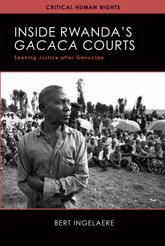|
Inside Rwanda’s Gacaca Courts
Seeking Justice after Genocide
Bert Ingelaere
Critical Human Rights
Steve J. Stern and Scott Straus, Series Editors
Winner of the 2017 Bethwell A. Ogot Book Prize, sponsored by the African Studies Association
The difficult path to peace in the wake of horrific crimes
After the 1994 genocide in Rwanda, victims, perpetrators, and the country as a whole struggled to deal with the legacy of the mass violence. The government responded by creating a new version of a traditional grassroots justice system called gacaca. Bert Ingelaere, based on his observation of two thousand gacaca trials, offers a comprehensive assessment of what these courts set out to do, how they worked, what they achieved, what they did not achieve, and how they affected Rwandan society.
Weaving together vivid firsthand recollections, interviews, and trial testimony with systematic analysis, Ingelaere documents how the gacaca shifted over time from confession to accusation, from restoration to retribution. He precisely articulates the importance of popular conceptions of what is true and just. Marked by methodological sophistication, extraordinary evidence, and deep knowledge of Rwanda, this is an authoritative, nuanced, and bittersweet account of one of the most important experiments in transitional justice after mass violence.
 Bert Ingelaere is a lecturer at the Institute of Development Policy and Management, University of Antwerp, Belgium. He is the coeditor of Genocide, Risk and Resilience: An Interdisciplinary Approach.
Bert Ingelaere is a lecturer at the Institute of Development Policy and Management, University of Antwerp, Belgium. He is the coeditor of Genocide, Risk and Resilience: An Interdisciplinary Approach.
Praise
“Warns of the dangers of romanticizing . . . local processes of transitional justice: notions of authenticity, tradition, and ‘truth’ are continually contested.”
—African Studies Review
“An exhaustively researched, thoroughly analyzed, and beautifully written trove of data on one of the most ambitious and controversial legal experiments of the twenty-first century.”
—Canadian Journal of African Studies
“Rigorous and reliable. It has much to say about the difficulties of reconciliation politics. Essential”
—Choice
"Systematically examines how ordinary people respond to the transitional justice enacted in their name. Ingelaere's multisited and multimethod ethnography is a model for how to get at local understandings of grassroots mechanisms. His findings suggest cautionary lessons for anyone interested in making postconflict justice and reconciliation more community-based."
—Lars Waldorf, University of York
“This masterful study provides a balanced, nuanced assessment of Rwanda’s local courts, showing how diverse social dynamics influenced both the operations of gacaca and its outcomes in different local communities. Essential reading for anyone interested in transitional justice and conflict resolution, in Rwanda and beyond.”
—Catharine Newbury, Smith College
Additional Resources
Listen to Bert Ingelaere speaking about this book:
New Books Network podcast http://newbooksnetwork.com/bert-ingelaere-inside-rwandas-gacaca-courts-seeking-justice-after-genocide-u-wisconsin-press-2016/
Publicity and Press Kit Resources
Click here for current & upcoming UW Press events
Download high resolution cover, color
Download high resolution cover, b/w
Download high resolution author photo, color
Download high resolution author photo, b/w
All images are at least 2.25 inches at 300 dpi wide; current title covers are a minimum of 1500 px wide/6 inches wide at 300 dpi. Please contact us if you need a custom size.
Media & bookseller inquiries regarding review copies, events, and interviews can be directed to the publicity department at publicity@uwpress.wisc.edu or (608) 263-0734. (If you want to examine a book for possible course use, please see our Course Books page. If you want to examine a book for possible rights licensing, please see Rights & Permissions.)
Of Related Interest
|

From War to Genocide
Criminal Politics in Rwanda, 1990ÔÇô1994
AndrÔöť─Ö Guichaoua; translated by Don E. Webster |

Court of Remorse
Inside the International Criminal Tribunal for Rwanda
Thierry Cruvellier |
|

Larger images
New in Paperback!
July 2018
LC: 2016012951 KTD
256 pp. 6 x 9
2 figures, 1 map, 15 tables
|

